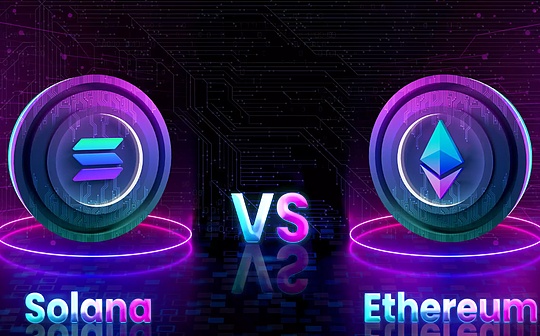Bankless: A quick look at the Ethereum upgrade roadmap

Reprinted from jinse
12/31/2024·4MAuthor: David C, William M. Peaster; Compiler: Deng Tong, Golden Finance
Vitalik Buterin's writing enthusiasm has increased this year, and as of 2024, he has published 25 posts on his blog.
It’s worth noting that his latest article is part of a series on “The Possible Future of the Ethereum Protocol,” with each article delving into a major part of the Ethereum roadmap:
Part One: The Merge: What else can be improved on Ethereum PoS
Part 2: The Surge: Vitalik: How should the Ethereum protocol develop during The Surge phase?
Part Three: The Scourge: Vitalik: Key Objectives of Ethereum’s The Scourge Phase
Part 4: The Verge: Vitalik: A Possible Future for Ethereum The Verge
Part 5: The Purge: Vitalik: The Possible Future of the Ethereum Protocol—The Purge
Part 6: The Splurge: Vitalik: The Possible Future of the Ethereum Protocol—The Splurge
Not surprisingly, these are some of the most fundamental writings we’ve seen throughout Ethereum’s history; that said, there’s a lot to know here. Before or even while diving into these articles, you may find that understanding the key points of each major upgrade helps to better grasp Vitalik's technical writings on the Ethereum roadmap.
To that end, here's a quick start guide to help you get up to speed on the basics of each major upgrade.
The Merge

Completed in 2022, the upgrade marks Ethereum's transition from Proof of Work (PoW) to Proof of Stake (PoS), reducing energy consumption by 99% and enhancing network security through staking. However, Vitalik Buterin said upgrades related to The Merge are underway.
The goal moving forward is to speed up transaction confirmation, reducing wait times to 4 seconds. Vitalik said another goal related to The Merge is to lower the staking requirement from 32 ETH to 1 ETH to allow more people to participate and help secure the network.
By speeding up confirmations and making it easier for everyone to stake, Ethereum will become more decentralized without compromising its security.
The Surge
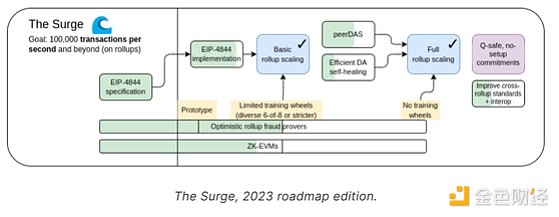
Surge aims to make Ethereum faster and more scalable, with the goal of processing over 100,000 transactions per second (TPS). This will be accomplished by optimizing layer 2 and improving data storage technology.
An important part of The Surge is EIP-4844, introduced in the Dencun upgrade in early 2024, which adds "blobs" - new block spaces used to store L2 data.
Next, when the Pectra upgrade is expected in 2025, PeerDAS will enhance the way Ethereum manages these blobs, increasing network bandwidth while keeping costs low. Data compression also helps reduce transaction size, further improving aggregation efficiency.
These upgrades will make Ethereum more scalable while remaining decentralized and secure.
The Scourge
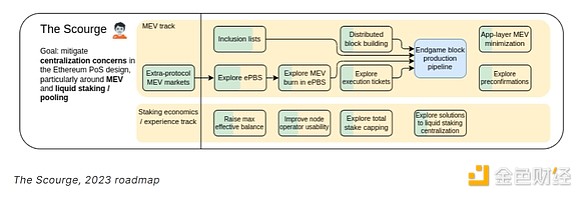
Scourge solves a major challenge: the risk of centralization in the Ethereum staking and block creation process.
Currently, building blocks (the process of choosing which transactions to make) favors big players who use advanced algorithms to make more money. This could lead to transaction delays or manipulation, which is detrimental to Ethereum’s decentralization goals.
To solve this problem, Ethereum plans to break the block construction work into smaller, more manageable parts. A proposal called inclusion lists would allow smaller validators to ensure certain transactions are included in blocks, reducing the power of large block builders.
Additionally, ongoing cryptographic mempool research aims to improve security by hiding transaction details until confirmed. The mempool is the waiting area before transactions are added to the block. Currently, anyone can view these pending transactions, which allows block builders to reorder them for profit (a practice known as MEV, or Maximum Extractable Value). By encrypting the mempool, transaction details are hidden until confirmed, reducing the chance of manipulation.
Additionally, Ethereum is looking at ways to reduce staking rewards to prevent too much concentration of network wealth in the hands of a few large validators. These joint efforts aim to keep Ethereum decentralized and protect users from exploitation.
The Verge
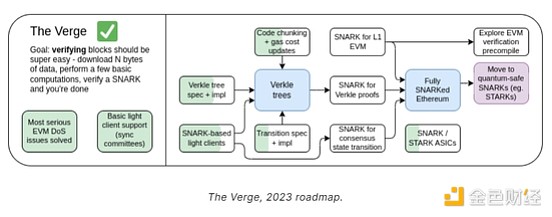
Currently, running a node requires storing hundreds of gigabytes of data, which can be a barrier for many users. The Verge aims to change this by introducing "stateless clients" that don't need to store all data. Instead, they will rely on cryptographic proofs (Verkle trees or STARKs) to verify the blockchain.
Stateless clients mean that even a mobile phone or basic laptop can fully verify Ethereum. This will greatly expand who can help run and secure the network, making it more decentralized. In the long term, Ethereum aims to use cryptographic proofs to verify entire blocks so that even low-power devices can quickly confirm that everything on the blockchain is correct.
The Verge is also considering making Ethereum quantum-resistant by replacing Verkle trees with more future-proof alternatives, ensuring the network can withstand emerging technologies such as quantum computing.
The Purge

Over time, the Purge plan will make Ethereum leaner and simpler.
As blockchains grow, they tend to accumulate more and more data, which each node must store, making it more difficult for new nodes to join the network. Purge solves this problem by reducing the need for nodes to retain all historical data and unused protocol functionality.
One of the goals of Purge is that history expires, where old data (such as transactions and accounts) is stored in a distributed fashion, similar to how torrent networks work. Instead of storing all past transactions, each node keeps only a portion of that history, with other nodes storing the other portions. This way, Ethereum can remain secure and decentralized, but nodes don't need large amounts of storage to join the network.
Another goal of Purge is state expiration, which solves the growth problem of "state data" such as account balances and contract storage. This involves automatically deleting or archiving unused data over time, making it easier to manage Ethereum’s long-term storage needs.
Additionally, the purpose of the Purge is to clean up old, rarely used network features and simplify the code to keep Ethereum efficient and accessible.
The Splurge
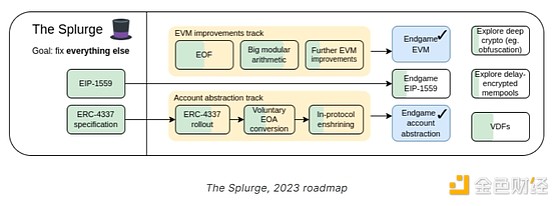
Splurge is Ethereum’s “finishing work” phase, focusing on various improvements that don’t fit neatly into other categories but are critical to enhancing Ethereum’s user experience and technical robustness.
One of Splurge’s main goals is to optimize the Ethereum Virtual Machine (EVM), Ethereum’s core computing engine, to make it faster and more secure. This includes adding features such as account abstraction, allowing users to create flexible, user-friendly accounts with advanced security options. Splurge is also working on improving the transaction fee mechanism to keep costs stable and fair, even as network demand fluctuates.
Additionally, Splurge continues to explore advanced cryptographic technologies that could make Ethereum more resilient to future technological changes, such as quantum computing. These upgrades are designed to future-proof Ethereum, ensuring that it remains a reliable platform for decentralized applications in the long term.
Summarize
These six major upgrade phases are the backbone of Ethereum’s development as a carefully architected, multi-layered system that balances innovation and practicality. These phases are not isolated but intertwined, with each upgrade balancing current needs with future-proofing the network.
Through this layered approach, Ethereum is adapting itself to become an excellent foundation for applications and interactions on a global scale—the types of applications and interactions we all expect online, and types we have yet to imagine. Along the way, the intentional design of the network will ensure that Ethereum remains adaptable, inclusive, and resilient.



